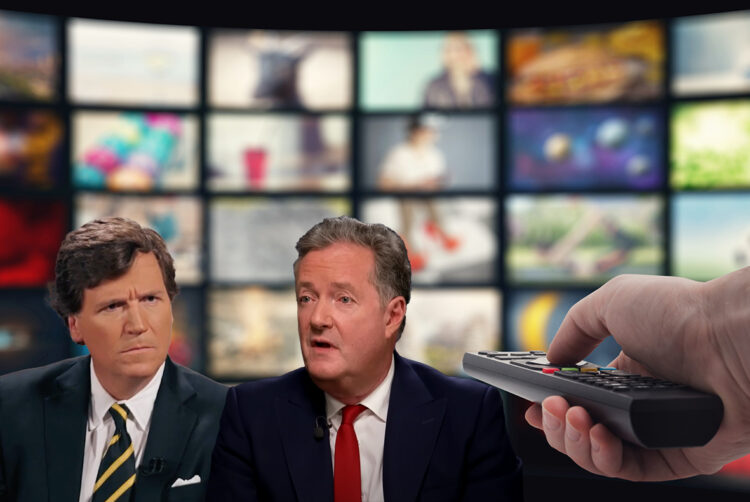What two big interviews tell us about the changing media landscape

Opinion
While Piers Morgan’s move to YouTube could be an experiment for News UK, Tucker Carlson showed the dangers of content untouched by conventional editorial standards.
Two high-profile, controversial journalists and TV presenters — one with considerably more credibility than the other — have demonstrated in dramatic fashion this week the seismic changes affecting the worlds of broadcasting and communication.
We have known for ages that relative unknowns can assemble, with the thinnest of material, vast audiences and associated wealth through the miracle of YouTube. This online potential has throw up toxic material that is difficult to control.
But who would have thought that a young American, MrBeast, could have signed up more than 350m YouTube subscribers largely through doing extravagant charitable deeds and may even be on the way to becoming the first YouTube billionaire (apart from its founders)?
Abandoning the straitjacket
There was still something remarkable about the decision by Piers Morgan to take his Piers Morgan Uncensored interview show to YouTube and off what he saw as the “straitjacket” of appearing at a regular time slot on the TalkTV linear broadcast channel.
The decision is a symptom of the fact that TalkTV has not exactly been a ratings hit — not even compared with GB News, which has a firm grip on the right-wing TV news audience, albeit complete with continuing disputes over the meaning of broadcast impartiality with media regulator Ofcom.
Morgan gets many big interviews, but on TalkTV he can still struggle to attract 100,000 viewers, while his Rishi Sunak interview — that of the infamous £1,000 bet that refugees would actually go to Rwanda before the election — romped to 430,000 on YouTube by Tuesday.
The change is not as dramatic as it first appears. Some of Morgan’s interviews will still be seen from time to time on TalkTV and he is almost certainly doing the work under his highly lucrative contract with the Murdoch family’s News UK, which owns the Piers Morgan Uncensored brand.
So Morgan hasn’t got rid of all his “straitjackets” and may have simply surrendered some of the immediacy and impact of network television.
Perhaps the manoeuvre is also partly an experiment to see whether it could provide a template for the loss-making channel once the election is over.
It is unthinkable for TalkTV to come off “the air” before an election while Rupert Murdoch is still lurking in the wings. But all that could change if, as at the moment seems very likely, the Conservatives lose the election — then the YouTube path could start to look very attractive and a lot less expensive than conventional broadcasting.
Unchallenged and unscrutinised
Morgan has had many questionable moments in his career, but at least they have been embedded in years of real journalistic achievement, including editing the News of the World and the Daily Mirror.
The same cannot be said of Tucker Carlson, whose interview last week with Russian leader Vladimir Putin is the other “seismic” event that showed how much things are changing in the media.
And the implications of this interview are much more serious. It gave Putin unchallenged and unscrutinised access to a world audience in what was the Russian president’s first interview with a Western broadcaster since the invasion of Ukraine.
For Putin, Carlson — sacked last year from his prominent perch on Fox News — had to be the obvious choice. After all, Carlson has said in the past that Nato existed mainly to torment Putin and he has been a willing spreader of Trump conspiracy theories before apparently falling out with Murdoch.
The “interview” has been widely criticised for allowing Putin to drone on with his eccentric view of Russian history, with Carlson failing to challenge him on the invasion and the atrocities committed by his troops against civilian populations.
Carlson even claimed, falsely, that mainstream journalists hadn’t bothered to ask Putin for interviews when, in fact, requests had been routinely refused.
Lack of standards
The two-hour session, carried on the Tucker Carlson Network, was flung out into the world unedited, lacking in either context or any attempt to rebut obvious lies.
And that is the danger of this new way of doing business: any old rubbish can be put out there, untouched by conventional editorial standards.
For Carlson, despite the criticism his performance attracted, the interview will have helped establish the presence of the Tucker Carlson Network and we can presumably look forward to more tendentious material of a similar standard, sans basic fact-checking.
Every new development and way of reaching eyeballs means more competition for scarce digital advertising revenue. This is obviously a serious concern for the established media, which is facing falls in revenue and there have been job losses at Reach and Channel 4, and possibly even at The Guardian, which stands to lose £39m in its latest financial year.
The YouTube shift
Yet when Morgan and Carlson are seeking greater freedom for their programming with the likes of YouTube, there is an obvious irony — YouTube may be heading in the opposite direction, towards something resembling broadcast television.
Subscribers to YouTube TV have risen from 5m to 8m since July and, yes, subscribers were able to watch Super Bowl coverage in 4K.
The increasing move towards television by YouTube is designed to increase viewing time and, with it, advertising dollars.
As digital strategist Graham Swallow has pointed out, a 10-minute video clip might get 250,000 views or 41,000 hours of watch time, whereas a two-hour video might have 500,000 views or 1m hours.
So the curious impact of Morgan and Carlson seeking to escape the limitations of broadcast television could end up offering streamers some of the longer-form viewing that they crave.
 Raymond Snoddy is a media consultant, national newspaper columnist and former presenter of NewsWatch on BBC News. He writes for The Media Leader on Wednesdays — read his column here.
Raymond Snoddy is a media consultant, national newspaper columnist and former presenter of NewsWatch on BBC News. He writes for The Media Leader on Wednesdays — read his column here.




